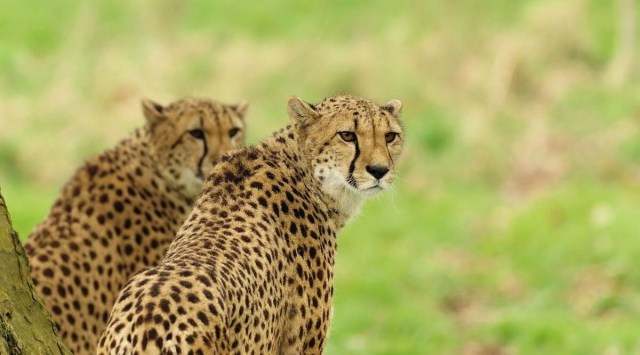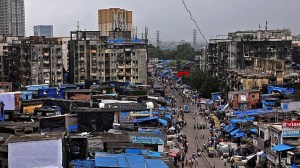After another cheetah death at Kuno, officials looking into ‘satellite collars’ as possible cause
Suraj was translocated from South Africa to KNP in February this year. With its death, eight felines, including three cubs born to Namibian cheetah Jwala, have died at the park since March.
 According to Madhya Pradesh wildlife authorities, a monitoring team spotted the cheetah, Suraj, “in a lethargic state around 6.30 am in the Masavani beat of Palpur East Zone”. (Representational/file image)
According to Madhya Pradesh wildlife authorities, a monitoring team spotted the cheetah, Suraj, “in a lethargic state around 6.30 am in the Masavani beat of Palpur East Zone”. (Representational/file image) One more male cheetah died at Kuno National Park (KNP) in Madhya Pradesh on Friday – the second one this week – taking the total number of feline fatalities this year to eight.
According to Madhya Pradesh wildlife authorities, a monitoring team spotted the cheetah, Suraj, “in a lethargic state around 6.30 am in the Masavani beat of Palpur East Zone”.
The team spotted a fly around its neck and when they tried to get close, the cheetah ran away.
“The monitoring team immediately informed the control room at Palpur via wireless about the condition of the cheetah. A wildlife medical team and regional officers reached the spot around 9 am. On tracing the cheetah’s location, it was found dead on the spot,” said a wildlife officer.
According to the officer, “initial investigation found the cause of the feline’s death to be wounds on the neck and back”.
“A detailed report on the cause of death will be prepared by the team of wildlife doctors after the autopsy. The cause of death will be clear only on the basis of the report,” said the officer.
Suraj was translocated from South Africa to KNP in February this year. With its death, eight felines, including three cubs born to Namibian cheetah Jwala, have died at the park since March.
Suraj’s death comes after the death of male cheetah Tejas, who was also found with injuries to its neck and back. The animal’s post-mortem report had revealed it was “internally weak” and could not recover from a “traumatic shock”.
Madhya Pradesh principal chief conservator of forests (wildlife) J S Chauhan told The Indian Express, “Both Tejas and Suraj have similar nature of injuries. We are yet to understand why those injuries were caused. We have ruled out injuries because of violent encounters with other big cats so far. In the case of Tejas, its internal organs had degraded and we are trying to find out the cause of that and have sent the samples for further examination.”
Chauhan said one of the causes could be the satellite collars wrapped around the Cheetah’s neck, which may have caused an infection. “We are looking into this aspect as well. The cheetah may have got an infection in that region because of the collar. It may have even scratched at the collar resulting in a subsequent infection,” he said.
South African cheetah expert Adrian Tordiffe, who was involved in the translocation of the cheetahs from Namibia and South Africa, told The Indian Express, “I saw the video of the cheetah that died and it dawned on me that this may be the result of an infection at the neck. If there is constant rainfall then the skin under the collar becomes infected due to constant moistness. This results in a systematic infection brought on by flies and maggots, eventually causing death.”
Adrian suggested that wildlife officials immediately examine all remaining cheetahs for signs of infection. “These are wild cheetahs and it is difficult for humans to monitor them closely. They need to be examined and checked for infections.”
State Forest Minister Vijay Shah said the deaths were common among wild animals and most of the deaths of the adult cheetahs were over food or mating. “This is common among wild animals… According to us, it is the third or fourth cheetah; we don’t count the cubs because they seemed like they would not survive,” Shah said.
Reacting to the news of the cheetah’s death, former environment minister and Congress party’s general secretary in-charge of communication Jairam Ramesh said: “Today should have been a day of unadulterated joy with the launch of Chandrayaan-3. Sadly, the news has just come in that the eighth cheetah has died at Kuno.”
“The expert group would surely be examining what is going wrong repeatedly. All that can be hoped for is that conservation science prevails over political prestige,” the senior Congress leader said on Twitter.
The cheetah reintroduction programme was launched at the Kuno park in September last year. A total of 20 cheetahs were translocated from Namibia and South Africa in September 2022 and February 2023 respectively to revive India’s cheetah population.
On July 11, a male cheetah, Tejas, was found dead with neck injuries inside enclosure number 6. On May 9, female cheetah Daksha, brought from South Africa, died following a “violent interaction” with two male cheetahs during mating.
Daksha’s death came close on the heels of the death of Uday, who had taken ill in April. On March 27, a Namibian cheetah named Sasha died of kidney complications. Sasha was believed to have contracted the ailment during its captivity in Namibia and had been unwell since its arrival at Kuno.
Three of the four cubs born to Jwala died in May. While the first cub died on May 23 due to suspected weakness, the other two died on May 25 due to “extreme weather conditions and dehydration”.







